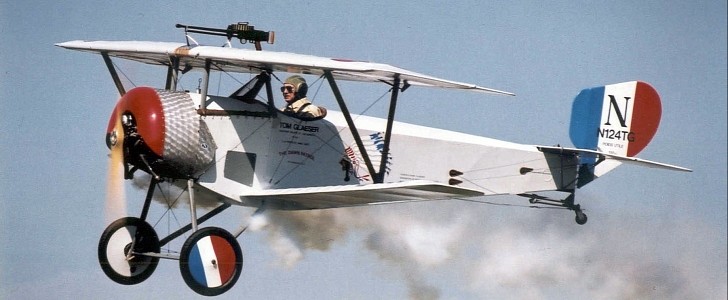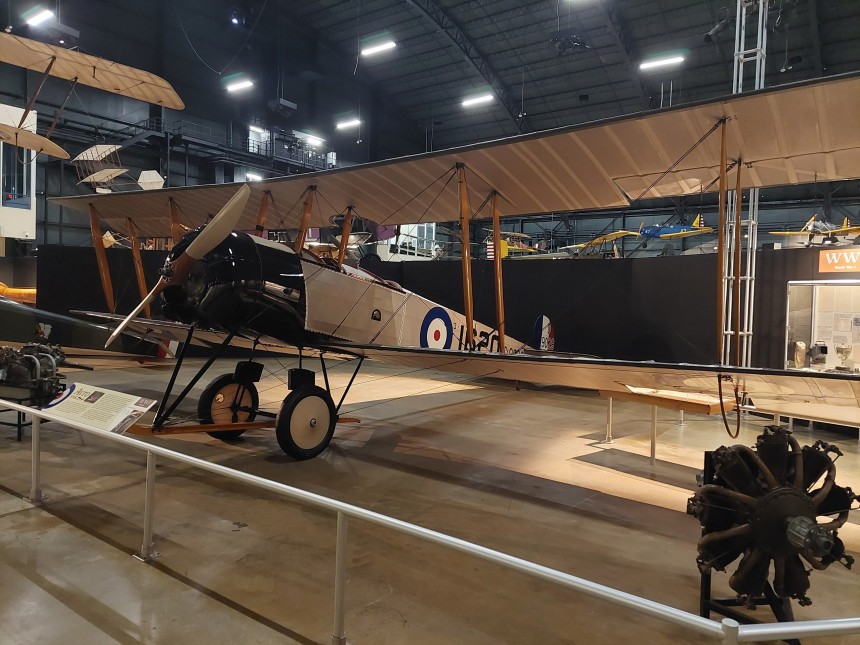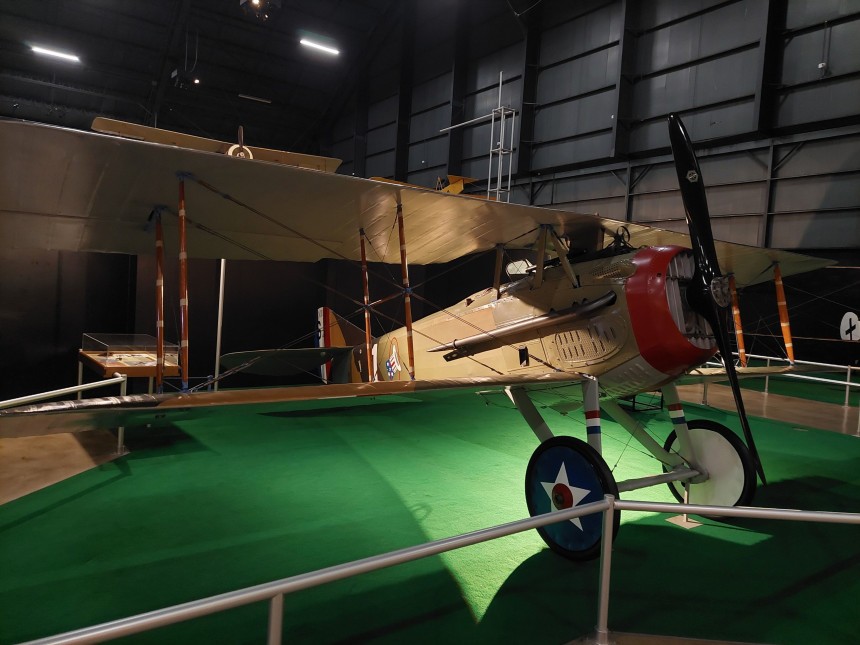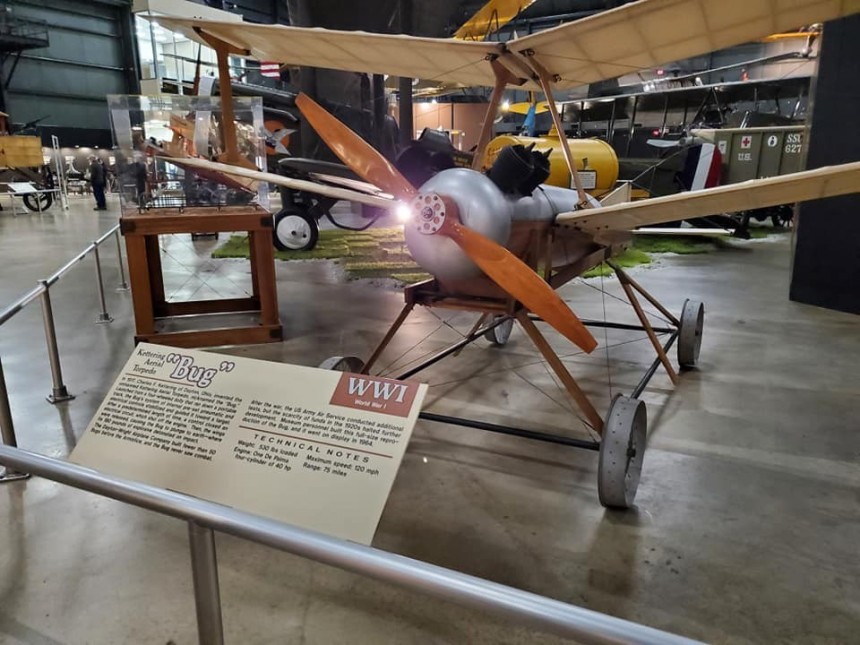It's a travesty that the First World War so often gets brushed aside in favor of discussing its ostensibly more present-day impactful second boogaloo. That's especially the case when it comes to the fighter aircraft these pioneer aviators flew into combat.
Consider that the first shots fired in the war in July 1914 came only 11 years after the genesis of powered aviation by the Wright Brothers in December 1903. A period where crewed aviation was so primitive, flight mechanics were only partially understood. The best way to visualize what the earliest air-to-air combat looked like is to see the planes themselves in the flesh. Luckily, the National Museum of the United States Air Force has got you covered.
Their First World War vintage military aircraft collection is one of the most extensive in North America. Only a handful of other collections in the world are comparable in scale. It's great for continuity's sake that the museum tour begins at this massive hangar filling exhibit space.
Iconic aircraft like the British Sopwith Camel, the French Spad XIII, and the German Halberstadt CL IV were constructed with materials that wouldn't pass for a serviceable tool shed in the modern day. We're talking paper thin canvas, forest fresh timber, and an absolute minimum of metal to account for the lack of horsepower under the hood.
Every kilo, every pound, and every ounce of weight mattered in these early fighters. Internal combustion wasn't the most well-understood power source on top of pioneering aviation. Underpowered behemoths like the French Le Rhone C-9 radial engine jetted a paltry 80 horsepower.
A modern three-cylinder economy car will easily match those numbers at a fraction of the weight. The Allied powers dropped their jaws in amazement when the 443 horsepower 12-cylinder Liberty engine showed up on the scene late in the war. The airplane engine was America's major technological contribution to the conflict.
Many of these early aero engines featured another groundbreaking feature of the day. An interrupter gear mechanism that allowed for machine-gun fire to pass through the propeller's blades without shooting it clean off the airplane. Guns like the Model 1918 M1 37mm cannon, these cannons were manufactured at the Watervliet Arsenal near Albany, New York. They were distributed throughout French and British fighting forces during the war.
Aerodynamic forces were little understood 100 years ago. In those days, it was perfectly acceptable to assume the best way to add more lift was to add more sets of wings. To these early engineers' credit, they weren't entirely wrong. The iconic German ace, Manfred Von Richthofen, so emphatically proved this in his Fokker Dr. 1 tri-plane.
It's thought as many as 19 of his air-to-air victories came in the maneuverable tri-plane. The one-to-one replica on display at the museum looked just as it did when the type served with the Jagdstaffel during the war. With the nicknamed Red Barron as their most famous member.
People like Richtoffen who were brave enough to climb into these canvas and wooden death traps are often fabled to have an expected survival time of as little as two-and-a-half weeks at the worst of times. Whether that figure is statistically accurate or not is really irrelevant. Seeing how flimsy and fragile these early warbirds are in the flesh makes that figure all the more believable.
That's assuming you were able to make it out of flight school in one piece. Training in aircraft like the Thomas-Morse S-4 Scout, one of the first American purpose-built military trainers, also displayed in the hangar alongside the fighters its pilots would spend one day graduating into.
Think cruise missiles are a modern invention? The museum's Kettering Bug exhibit proves you wrong. The buzzy little drone's tiny gasoline engine was meant to fly over enemy positions and detonate a payload over enemy lines at a speed of 50 miles per hour (80.46 kph). This weapon ultimately never got past the testing phase, but what a groundbreaking concept it was.
Bi-planes shared the skies with massive hydrogen airships called Zeppelins. These enormous craft could remain aloft for hours and rain hellfire down on enemy cities. All while pilots of Zepplin and bi-planes alike flew in raggy leather helmets, long leather coats, and a pair of goggles as their only barrier between themselves and the harsh altitude elements. Not to mention a constant stream of oil leaking from the primitive engines at all times during routine flights.
So maybe next time you're thinking about iconic air battles of history, don't forget to include the First World War in your conjecture. Any of us modern folks would probably crisp up into a burnt human biscuit before even being able to get off the ground in some of these planes. People 100 or so years ago must have been made of tougher stuff.
Their First World War vintage military aircraft collection is one of the most extensive in North America. Only a handful of other collections in the world are comparable in scale. It's great for continuity's sake that the museum tour begins at this massive hangar filling exhibit space.
Iconic aircraft like the British Sopwith Camel, the French Spad XIII, and the German Halberstadt CL IV were constructed with materials that wouldn't pass for a serviceable tool shed in the modern day. We're talking paper thin canvas, forest fresh timber, and an absolute minimum of metal to account for the lack of horsepower under the hood.
Every kilo, every pound, and every ounce of weight mattered in these early fighters. Internal combustion wasn't the most well-understood power source on top of pioneering aviation. Underpowered behemoths like the French Le Rhone C-9 radial engine jetted a paltry 80 horsepower.
Many of these early aero engines featured another groundbreaking feature of the day. An interrupter gear mechanism that allowed for machine-gun fire to pass through the propeller's blades without shooting it clean off the airplane. Guns like the Model 1918 M1 37mm cannon, these cannons were manufactured at the Watervliet Arsenal near Albany, New York. They were distributed throughout French and British fighting forces during the war.
Aerodynamic forces were little understood 100 years ago. In those days, it was perfectly acceptable to assume the best way to add more lift was to add more sets of wings. To these early engineers' credit, they weren't entirely wrong. The iconic German ace, Manfred Von Richthofen, so emphatically proved this in his Fokker Dr. 1 tri-plane.
It's thought as many as 19 of his air-to-air victories came in the maneuverable tri-plane. The one-to-one replica on display at the museum looked just as it did when the type served with the Jagdstaffel during the war. With the nicknamed Red Barron as their most famous member.
That's assuming you were able to make it out of flight school in one piece. Training in aircraft like the Thomas-Morse S-4 Scout, one of the first American purpose-built military trainers, also displayed in the hangar alongside the fighters its pilots would spend one day graduating into.
Think cruise missiles are a modern invention? The museum's Kettering Bug exhibit proves you wrong. The buzzy little drone's tiny gasoline engine was meant to fly over enemy positions and detonate a payload over enemy lines at a speed of 50 miles per hour (80.46 kph). This weapon ultimately never got past the testing phase, but what a groundbreaking concept it was.
Bi-planes shared the skies with massive hydrogen airships called Zeppelins. These enormous craft could remain aloft for hours and rain hellfire down on enemy cities. All while pilots of Zepplin and bi-planes alike flew in raggy leather helmets, long leather coats, and a pair of goggles as their only barrier between themselves and the harsh altitude elements. Not to mention a constant stream of oil leaking from the primitive engines at all times during routine flights.



















